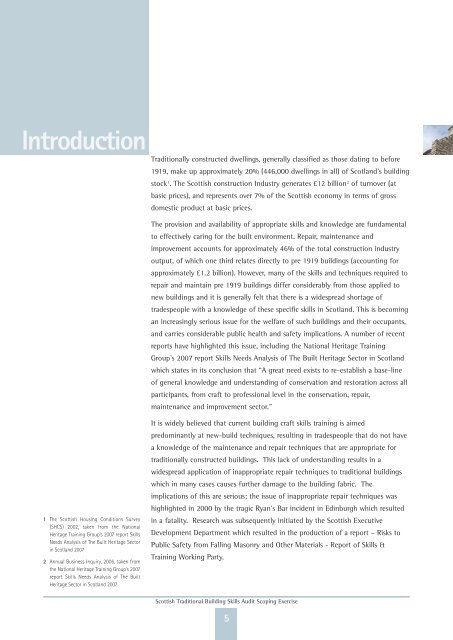Scottish Traditional Building Skills Audit Scoping ... - Historic Scotland
Scottish Traditional Building Skills Audit Scoping ... - Historic Scotland
Scottish Traditional Building Skills Audit Scoping ... - Historic Scotland
Create successful ePaper yourself
Turn your PDF publications into a flip-book with our unique Google optimized e-Paper software.
Introduction<br />
<strong>Traditional</strong>ly constructed dwellings, generally classified as those dating to before<br />
1919, make up approximately 20% (446,000 dwellings in all) of <strong>Scotland</strong>’s building<br />
stock 1 . The <strong>Scottish</strong> construction Industry generates £12 billion 2 of turnover (at<br />
basic prices), and represents over 7% of the <strong>Scottish</strong> economy in terms of gross<br />
domestic product at basic prices.<br />
The provision and availability of appropriate skills and knowledge are fundamental<br />
to effectively caring for the built environment. Repair, maintenance and<br />
improvement accounts for approximately 46% of the total construction industry<br />
output, of which one third relates directly to pre 1919 buildings (accounting for<br />
approximately £1.2 billion). However, many of the skills and techniques required to<br />
repair and maintain pre 1919 buildings differ considerably from those applied to<br />
new buildings and it is generally felt that there is a widespread shortage of<br />
tradespeople with a knowledge of these specific skills in <strong>Scotland</strong>. This is becoming<br />
an increasingly serious issue for the welfare of such buildings and their occupants,<br />
and carries considerable public health and safety implications. A number of recent<br />
reports have highlighted this issue, including the National Heritage Training<br />
Group’s 2007 report <strong>Skills</strong> Needs Analysis of The Built Heritage Sector in <strong>Scotland</strong><br />
which states in its conclusion that “A great need exists to re-establish a base-line<br />
of general knowledge and understanding of conservation and restoration across all<br />
participants, from craft to professional level in the conservation, repair,<br />
maintenance and improvement sector.”<br />
1 The <strong>Scottish</strong> Housing Conditions Survey<br />
(SHCS) 2002, taken from the National<br />
Heritage Training Group’s 2007 report <strong>Skills</strong><br />
Needs Analysis of The Built Heritage Sector<br />
in <strong>Scotland</strong> 2007<br />
2 Annual Business Inquiry, 2006, taken from<br />
the National Heritage Training Group’s 2007<br />
report <strong>Skills</strong> Needs Analysis of The Built<br />
Heritage Sector in <strong>Scotland</strong> 2007<br />
It is widely believed that current building craft skills training is aimed<br />
predominantly at new-build techniques, resulting in tradespeople that do not have<br />
a knowledge of the maintenance and repair techniques that are appropriate for<br />
traditionally constructed buildings. This lack of understanding results in a<br />
widespread application of inappropriate repair techniques to traditional buildings<br />
which in many cases causes further damage to the building fabric. The<br />
implications of this are serious; the issue of inappropriate repair techniques was<br />
highlighted in 2000 by the tragic Ryan’s Bar incident in Edinburgh which resulted<br />
in a fatality. Research was subsequently initiated by the <strong>Scottish</strong> Executive<br />
Development Department which resulted in the production of a report – Risks to<br />
Public Safety from Falling Masonry and Other Materials - Report of <strong>Skills</strong> &<br />
Training Working Party.<br />
<strong>Scottish</strong> <strong>Traditional</strong> <strong>Building</strong> <strong>Skills</strong> <strong>Audit</strong> <strong>Scoping</strong> Exercise<br />
5













![Elgin Cathedral Wedding Brochure [pdf, 544kb] - Historic Scotland](https://img.yumpu.com/22301571/1/190x151/elgin-cathedral-wedding-brochure-pdf-544kb-historic-scotland.jpg?quality=85)



